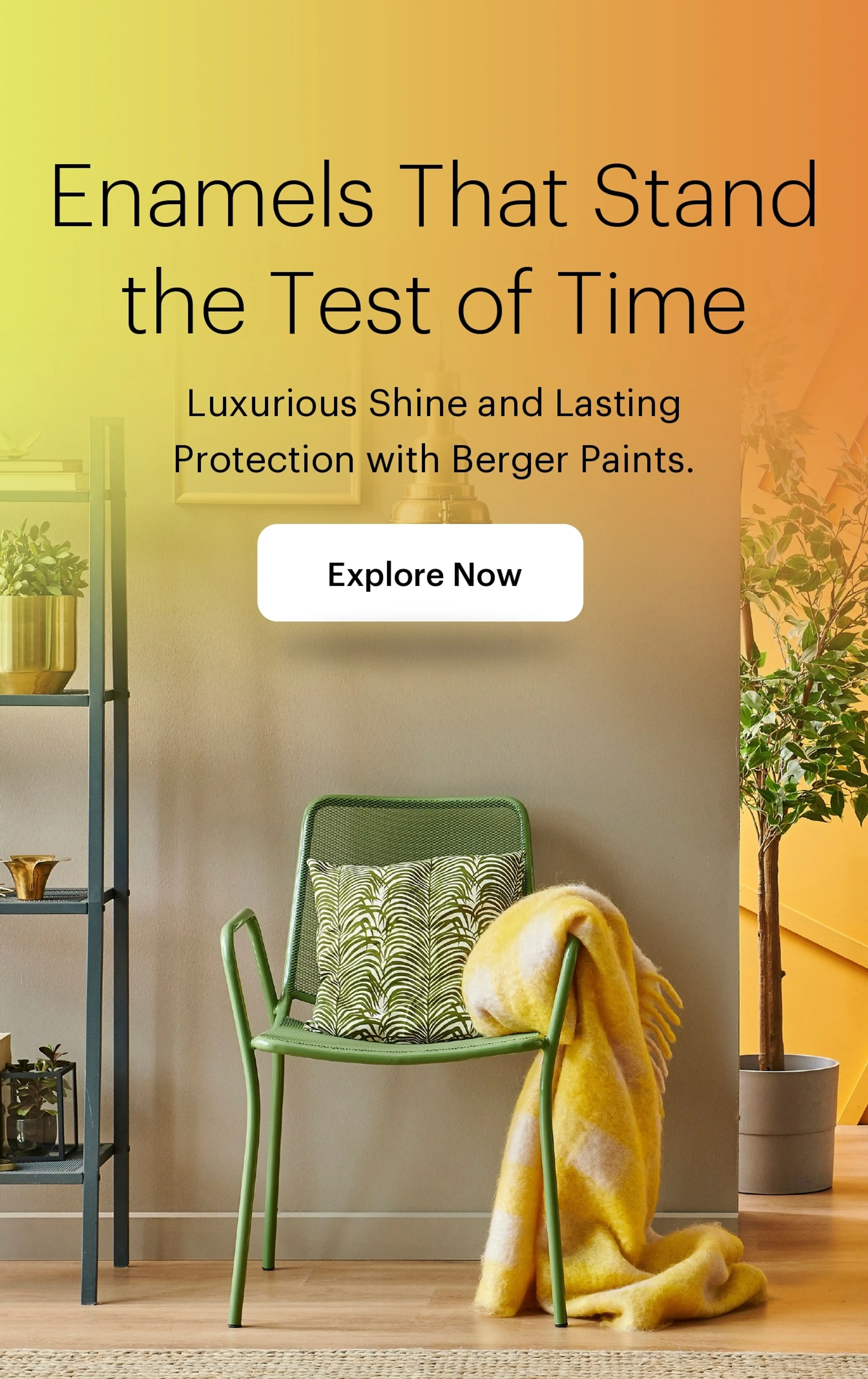

Enamel Paints for Metal and Wood Surfaces
Enamel Paints for Metallic & Wooden Surfaces
Enamel paint is a durable, glossy paint used on wood, metal, and walls to create a smooth, protective layer. It resists water seepage, stains, scratches, and prevents algal and fungal growth, making it ideal for surfaces like walls, furniture, and doors. Available in various shades, enamel paint ranges from white to golden brown.
Enamel Paint Its Features and Characteristics
Enamel paint is a type of paint that has an attractive glossy, yet smooth, finish. This paint is applied on wood, metal, and walls because it creates a strong, long-lasting layer that protects the material on which it is applied.
You might be wondering, how exactly is a layer of paint protective? Enamel paint forms a tough layer on the surface it is applied to, reducing the risk of water seepage, it is stain and scratch resistant. Basically, your walls, furniture, wooden doors, etc. - are all protected from algal and fungal growth, ugly scratches, dirty stains from food, ink, and so on.
Enamel paint colours range from enamel white paint to golden brown enamel paint.
Types of Enamel Paint: Synthetic, Water-Based, and More
Even when it comes to this one enamel paint, there are many different types.
Synthetic enamel paint: It’s an oil-based enamel paint that has a hard, glossy finish. What is synthetic enamel used for? This gloss enamel paint is used for doors, windows, and even furniture because it is stain-resistant and withstands repeated cleaning.
Water-based enamel paint: Water-based enamel paint is a low-maintenance choice that is easy to clean and dries faster than synthetic enamel paint. Water-based acrylic enamel paint is perfect for interior enamel paint.
PU enamel paint: PU enamel paint, a polyurethane-based enamel paint, creates a tough surface that resists chemicals and scratches, making it a good choice for places like floors.
- Acrylic enamel paint: Acrylic enamel paint is made with fast-drying acrylic resins. It dries quickly, stays flexible, and resists cracking from temperature changes, unlike many other paint types.
- Epoxy enamel paint: What is epoxy enamel paint? It is enamel paint that comes in two parts that need to be mixed before painting. One part contains epoxy resins, which create a hard and water-resistant surface on drying.
Gloss and Satin Enamel Finishes for Walls and Wood
Gloss enamel paint has a shiny finish that reflects light. It's usually reserved for doors, windows, and railings. It’s also easy to clean.
Satin enamel paint has a smooth look and isn't as shiny. It is also stain and dirt-resistant but doesn’t reflect as much light. Some colour satin enamel paints look better than the others. To select the best colours for your house, go through a colour catalogue.
Where Can You Use Enamel Paint?
Enamel paint works on many surfaces, but some combinations give better results than others.
Best Enamel Paint for Metal Surfaces: Durable Protection
Metal gates, grills, and railings need enamel paint for metal because it protects from rust and damage from harsh weather.
Which is the best enamel paint for metal? Paints from Berger’s premium range including Hi Gloss Enamel and Luxol Satin Enamel are safe options for both indoor and outdoor metal surfaces.
Best Enamel Paint for Wood: A Classic Choice
Enamel paint for wood is widely used for furniture, doors, and cabinets because it prevents chipping and fading.
Which is the best enamel paint for wood? Luxol Hi-Gloss Enamel wall paint gives an elegant and polished look. For darker finishes, mahogany enamel paint works well.
Enamel Paint for Walls: Interior and Kitchen Applications
Enamel paint for kitchen walls is a smart choice because it resists stains. Interior enamel paint is great for places like hallways. Water-based enamel is best for easy cleaning and maintenance.
Pre-painting Tips When Using Enamel Paint
- Clean the surface: Wipe dust, dirt, and oily stains so the paint sticks properly. If you skip this, the paint will eventually peel or look uneven.
- Fill holes and cracks: Use putty to smooth out unevenness. If you don't do this, no matter how good a job you do with the actual painting, the paint will look uneven and bad.
- Apply primer: Primer helps enamel paint stick better and last longer. Without it, the paint may wear off quickly.
- Proper ventilation: Synthetic enamel paint needs ventilation to dry properly. Poor ventilation will increase drying time and lead to a sticky finish.
How to Apply Enamel Paint for Best Results
- Start with an enamel paint roller for an even coat. We suggest using an enamel paint roller instead of a brush because a brush tends to leave streaks; a roller will spread the paint evenly without leaving behind ugly marks.
- What can I use to thin enamel paint? You cannot use enamel paint straight from the tub because if the paint is too thick, it won’t spread properly and may dry with lumps. To thin the enamel paint, go for turpentine or a recommended thinner for synthetic enamel paint.
- Apply multiple coats: Two to three coats are enough to give you decent coverage. If you stop at one, the surface could look uneven.
- Drying time: Gloss enamel paint takes around 6-8 hours to dry fully.
You can get your very own high-quality DIY enamel paint kit and start painting today!
Frequently Asked Questions
Berger's enamel paints range are easy to care for! For routine cleaning of surfaces painted with Berger's enamel paint, use a soft cloth or sponge with mild soap and water.
Yes, Berger Paints offers metal paints formulated to be applied directly over rust on metal surfaces. These metal surfaces will have to be prepped and primed before enamel paint application by our trained and experienced team of painters. However, each product has its unique properties, so make sure to consult with our professional team for any queries for personalised advice and recommendations.
Yes, enamel paints are usually UV resistant and have anti-fading properties too! Our recommendation would be to try out our premium enamel paint- Luxol PU Enamel by Berger Paints. Known for its highly glossy finish, it offers exceptional durability for both interior and exterior surfaces, maintaining its vibrant appearance even when exposed to sunlight over time.
Yes, Berger Paints offers a wide range of coloured metal paints. Explore the diverse colour options available in our Luxol Enamel Paint collection to add vibrancy and protection to your metal surfaces.
The difference between enamel paint and regular paint (like emulsion and distemper) is the finish and lifespan.
Enamel paint has a tough, glossy finish that creates a protective layer on surfaces, stopping water leakage, and damage from scratches and stains. Enamel paint can be used on metal, wood, walls, and so on.
Regular paints, like emulsion, have a more delicate finish and are mainly meant for use on walls. The biggest difference between emulsion paint and enamel paint is that the former is easier to clean but not as long-lasting as enamel paint.
Yes, applying a primer before enamel paint is very much recommended. Primer creates a smooth base, improves paint adhesion, and increases the paint’s lifespan.
For best results, apply two to three coats of enamel paint.
Enamel paint dries in 6-8 hours for the first coat, but full curing can take 24-48 hours.
Yes, enamel paint is heat-resistant. Practically speaking, this facet makes it a great choice for kitchen walls, metal gates, and grills.
But what's important to note is that different types of enamel paint have different levels of heat resistance:
- Epoxy enamel paint: Highly heat-resistant, used for industrial applications.
- Synthetic enamel paint: Resists heat at moderate levels but you could start to see a slight discolouration if exposed to extreme temperatures for a long time.
One litre of enamel paint covers 100-120 sq. ft. per coat, but this depends on the surface type and application method.
- Smooth surfaces (like metal or wood that has been coated with a primer) need less paint and have better coverage.
- Rough surfaces (like unprimed wood) absorb more paint, reducing coverage.
Yes, enamel paint is waterproof, meaning it repels water and controls water damage. This makes it a great choice for bathroom doors, kitchen drawers, and terrace furniture. Epoxy enamel paint has the best water resistance; synthetic enamel paint has the ability to resist water to a certain extent but will get damaged with prolonged exposure to water.
